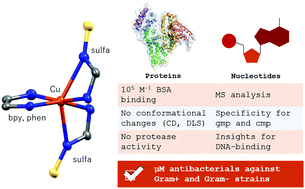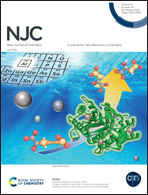Sulfonamide-containing copper(ii) complexes: new insights on biophysical interactions and antibacterial activities†
Abstract
Copper(II)–sulfonamide–(N^N) complexes are a promissing class of compounds resulting from the combination of bioactive organic drugs with the Cu–(N^N) motif. Here, we expand on the studies of three of such compounds that we had previously reported to be effective metallonucleases with promising antiproliferative activities. Since the compounds were previously shown to interact with DNA mostly in a non-covalent form, in this study we investigated their interactions with specific nucleotides to evaluate possible ligand replacement and preferential purine or pyrimidine base binding. Results showed partial ligand dissociation followed by non-preferential nucleotide binding in the conditions of mass spectrometric experiments. Additional biophysical studies of the interaction between the complexes and serum albumin, which is an important class of carriers of metallodrugs in plasma were performed and described for the first time here. Fluorescence spectroscopy indicated binding of the compounds to albumin, while dynamic light scattering (DLS) and circular dichroism (CD) data indicated no significant alteration of protein secondary structure or agglomeration. The compounds showed no protease activity on serum albumin or on lysozyme, a smaller protein, even in the presence of a reducing agent. The absence of protease activity is an important factor when it is considered the compounds can be transported by serum albumin and, when combined with data we reported previously, also indicates that DNA is more prone to cleavage by the compounds. Since both sulfonamides and copper(II) complexes have antibacterial effects, here we investigated the antibacterial activity of the complexes on three prevalent bacterial strains (Staphylococcus aureus, Escherichia coli and Psedomonas aeruginosa) with results indicating that the compounds are more active towards the Gram-positive S. aureus strain. The combination of the Cu–(N^N) motif with synergic sulfonamide ligands leads to metallonucleases with potential application in various biological endpoints.



 Please wait while we load your content...
Please wait while we load your content...